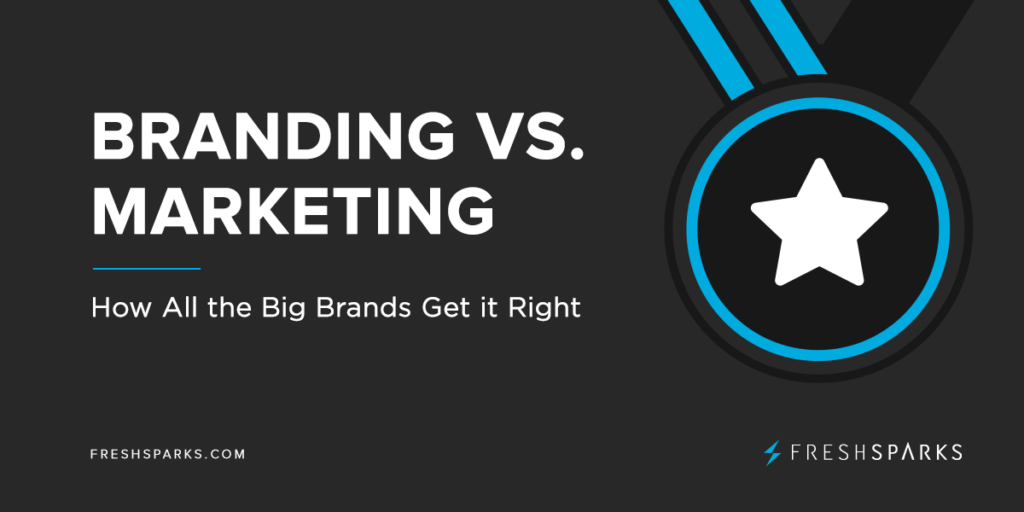
As an agency owner providing branding and marketing services, I’m asked a lot about the importance of branding vs. marketing. The truth is, that’s a tough question to answer, because it’s the wrong way to look at it.
The conversation shouldn’t be about branding vs. marketing. You don’t need branding “or” marketing.
You need branding AND marketing.
Branding and marketing are two different concepts that work together to elevate your business.
In fact, 92% of marketing professionals claim that brand authenticity is essential.
In this guide, I’ll break down
… the difference between branding and marketing,
… how each serves a unique purpose, and
… why successful businesses need a balance of both.
You’ll see examples of some of the biggest brands that get both branding and marketing right. 👍🏽
And some examples of where big brands didn’t understand the assignment. 👎🏽
By the time you’re finished reading, you’ll have a clear sense of where branding stops and marketing begins—and how they overlap to harness each for greater impact.
Ready for an education in branding and marketing? Come with me…
THE ULTIMATE GUIDE TO BUILDING YOUR BRAND
Use our step-by-step branding process workbook with tips, templates, and guidance to help build a brand for your business! Define your target audience, research competitors, develop a voice…and more.
Let’s look at a quick definition of branding and marketing, before getting into the difference between the two.
What is Branding?
Branding is the foundation of your business’s identity. Think of it as the unique fingerprint that sets your business apart from all the others.
While a lot of people think branding is just a logo or clever ads, they are mistaken.
Branding is actually the entire experience you create for your customers.
Your brand is your promise: it’s how you make people feel, what they remember, and why they keep coming back to you.
A well-defined brand reflects…
❤️ Your values
🗣️ Your voice
💗 Your “why” behind what you do
A strong brand strategy can elevate a business from a product or service to an experience that customers trust, admire, and feel connected to.
Let’s look at Apple as an example –
The Apple brand goes well beyond just selling devices; it represents innovation, creativity, and premium quality.
Apple is always pioneering the spirit of the individual…one that thinks differently, and not the status quo.
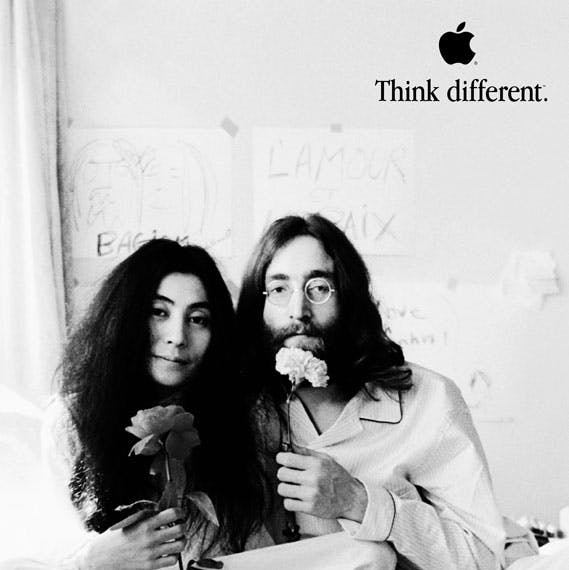
Think about their signature products:
- iPod
- iPad
- iTunes
- iOS
All of these things begin with the letter “I”…the Individual having the power of these “things” in their hands to explore their creative mind.
The iconic logo, minimalist design, and sleek packaging are all extensions of Apple’s brand identity.
Apple’s consistent branding builds customer loyalty to the point where over 90% of iPhone users stick with Apple instead of switching to other brands. (Sorry, Android users – I see you.)
This loyalty is a direct result of branding vs. marketing—it’s not just about the product itself but the emotional connection and experience Apple builds.
There is a certain feeling you get when using their well-designed products – purely by association.
Another classic example is Coke –
Their brand is so strong that 94% of the world’s population recognizes Coca-Cola’s logo.
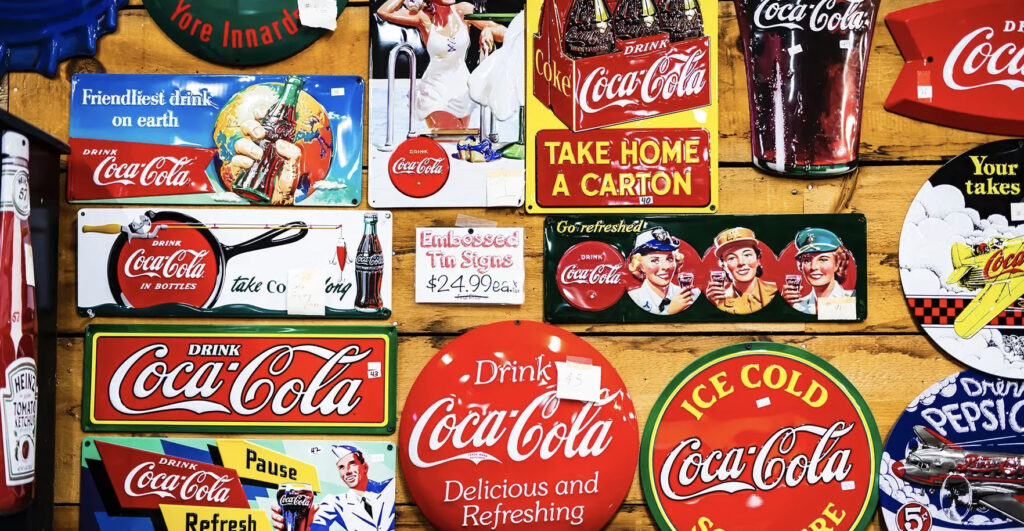
Their classic red color, distinctive font, and consistent messaging (and product) have created a brand people remember and trust.
To go deeper, the Coke brand is synonymous with happiness and connection. Coca-Cola isn’t just selling a drink; it’s selling moments of joy and nostalgia.
You can see how this is communicated through just an image and caption in their marketing –
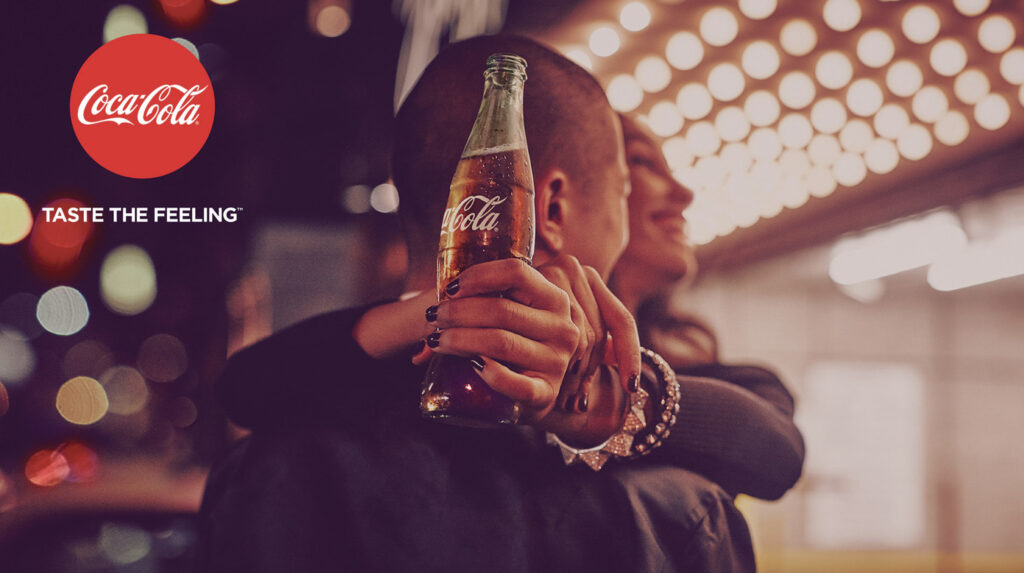
That’s the purpose of branding: to create a lasting impression.
Unlike marketing, which can change with trends, branding is built to be steady and consistent. It’s your identity, and it should remain recognizable over time.
Brand building gives meaning to your business, helping customers understand who you are and why you matter.
Learn More: 11 Simple Steps For A Successful Brand Building Process
Now that we’ve gone over the purpose of branding, let’s look at a simple definition of marketing.
What is Marketing?
If branding is your personality, marketing is how that personality gets introduced to the world.
Marketing is the strategy and tools you use to reach your audience and communicate your brand’s message.
It’s your social media posts, email campaigns, blog content, and even that irresistible limited-time offer.
Essentially, marketing is about action—it’s everything you do to spread the word, connect with your audience, and encourage them to engage with your business.
Think of it like this…
📝 Branding is the message
📢 Marketing is the megaphone
Where branding gives your business an identity, marketing amplifies it.
A well-crafted marketing strategy is how you turn brand awareness into meaningful relationships and, ultimately, loyal customers.
Bill Backus, Head of National Brand for Childhelp, summarizes the difference between branding vs. marketing very succinctly:
“Branding is the art of defining and shaping all the touchpoints that evoke emotion. It stems from a company’s foundational story or purpose…building a meaningful relationship over time. Marketing is the science of analyzing data to optimize the emotional impact of those touchpoints. It refines the connection between the brand and its audience.”
As you can see, marketing is fueled by data and should adapt to trends and customer needs.
Unlike branding, which is steady, marketing is flexible. It’s the reason why you see new ads and fresh campaigns—marketing thrives on keeping things relevant.
In fact:
Marketing often uses data to adjust messaging in real-time, making it responsive to what resonates with the audience.
Learn More: 19 Important Metrics for Measuring Digital Marketing Success
One of the most famous examples of marketing that perfectly embodies a brand is Coca-Cola’s “I’d Like to Buy the World a Coke” campaign from 1971.
Above, I discussed how Coke’s brand is about happiness and connection.
This marketing campaign wasn’t just about selling soda—it was about sharing a message of unity, happiness, and harmony that aligned perfectly with Coca-Cola’s brand values.
By showing people from different backgrounds coming together to sing about sharing a Coke, the campaign tapped into universal themes of peace and togetherness. It reflected Coca-Cola’s long-standing brand message of happiness and connection, reinforcing that Coke isn’t just a beverage; it’s a symbol of positive experiences and shared moments.
This campaign based on branding vs. marketing strategy didn’t just drive sales; it strengthened the emotional connection consumers felt with Coca-Cola.
Marketing is where the action happens—it’s about creating campaigns and strategies that reach the right audience and make them care.
Learn More: 3 Ways to Build a Solid Brand Reputation With Social Media
However –
Care alone isn’t enough to pay the bills. Luckily, effective business branding and marketing strategy can transform brand awareness into revenue through purchases and engagement.
Here are some examples…
Nike
Nike’s “Just Do It” campaign is a prime example of effective marketing aligned with brand identity.
Check out this Blast from the Past:
When Nike launched this campaign in the late 1980s, it resonated with athletes and fitness enthusiasts alike, growing Nike’s sales from $877 million to $9.2 billion in just a decade.
This brand campaign isn’t only memorable and enduring but also embodies Nike’s brand values of courage, resilience, and empowerment. These values have turned “Just Do It” into an iconic slogan in the sports industry.
I’ve gotten through two marathons feeling motivated by the Nike brand! (Yes, that’s me crossing the finish line in a FreshSparks racing bib – always marketing. 😉)

Dove
Dove’s Real Beauty campaign is another brand and marketing strategy success story. Dove’s marketing is closely tied to its brand message: inclusivity and self-acceptance.
Through ads showcasing women of all shapes, sizes, and backgrounds, Dove’s Real Beauty campaign achieved high engagement and helped the brand expand its reach.
This focus on genuine self-expression brought Dove closer to its target audience, with sales jumping from $2.5 billion to over $4 billion in a few years, all due to an authentic brand-backed marketing strategy.
With an effective branding and marketing strategy, your voice doesn’t just reach people—it speaks to them directly.
3 Key Differences Between Branding and Marketing
Now that we know what branding vs. marketing are individually, let’s take a closer look at how they’re different.
1. Branding is Long-Term. Marketing is Campaign-Driven.
Branding is about consistency and longevity, creating a lasting impression that shapes how people perceive a company over time.
I’m not even a soda drinker, but let’s look at Coca-Cola again, as a classic example of a brand that has maintained a consistent message for over a century.
To reiterate:
Coca-Cola’s branding has always centered around emotion – like happiness, connection, and shared moments. From the iconic red logo to the “Share a Coke” bottle campaign, Coca-Cola’s branding consistently reinforces its values, aiming to create a positive emotional experience and a sense of togetherness.
On the other hand, Coca-Cola’s marketing is dynamic and adaptable, responding to cultural moments and customer trends through distinct campaigns.
Each campaign is designed to engage people in fresh ways while staying true to the brand’s core message.
Take the “I’d Like to Buy the World a Coke” campaign above, for instance. This ad was created at a time when cultural tensions were high, and it used music and imagery to deliver a message of unity and peace, aligning beautifully with Coca-Cola’s brand promise of happiness and connection.
By focusing on a world that could come together over something as simple as a Coke, the campaign didn’t just sell soda; it reinforced the brand’s values in a relevant, timely way.
Years later, Coca-Cola introduced its “Share a Coke” campaign, swapping out its logo for people’s names on bottles to encourage consumers to “share” a Coke with someone they cared about.
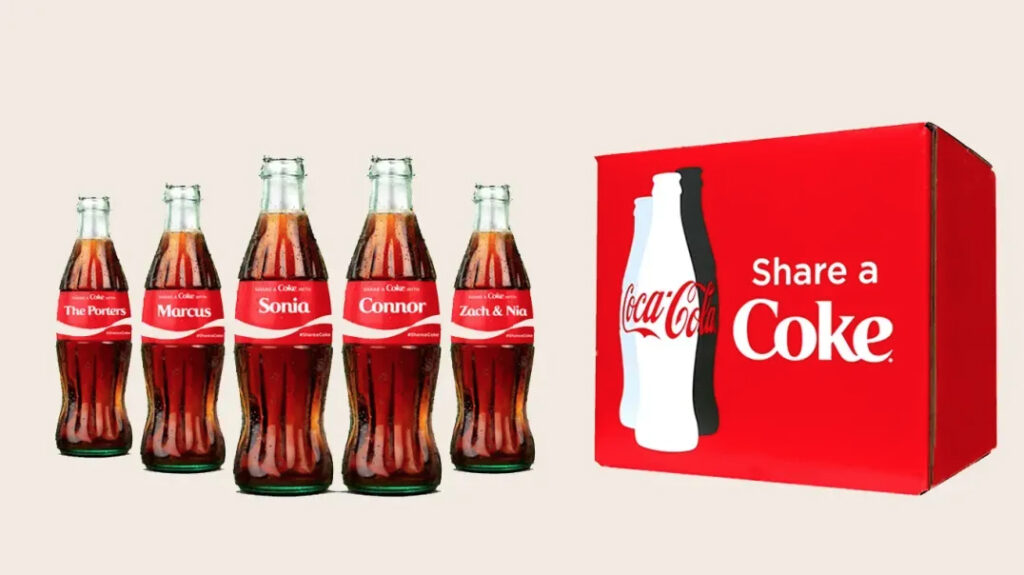
This branding and marketing effort was campaign-driven, adapting Coca-Cola’s timeless brand of connection to modern culture by tapping into the trend of personalization.
The campaign became an instant hit and significantly boosted sales, demonstrating how an adaptable marketing strategy can amplify a brand’s message in a way that resonates with a new generation.
Through these branding vs. marketing examples, we see how Coca-Cola’s branding remains a steady constant—a symbol of connection, joy, and shared moments—while its marketing adapts to cultural moments and trends to keep the brand relevant and engaging.
While branding is the North Star, guiding Coca-Cola’s identity over time, marketing is the vehicle that creatively brings that identity to life in ways that captivate the current audience.
2. Branding Builds Loyalty. Marketing Drives Engagement.
Branding creates loyalty by building trust – while marketing drives engagement.
Take Patagonia as an example.
Patagonia’s brand is built on environmental activism and sustainable practices.
Their loyal customers support them because they stand for something meaningful.
When Patagonia donates a percentage of sales to environmental causes, it isn’t just marketing; it’s living its brand values.
Patagonia’s marketing often centers on its brand purpose rather than products.
Campaigns like “The Common Threads Initiative” encouraged customers to reduce waste by repairing and reusing products rather than buying new ones.

This message was bold—Patagonia launched ads saying, “Don’t Buy This Jacket,” asking people to consider the environmental impact of their purchases.
This counterintuitive approach sparked conversation, strengthened Patagonia’s brand as environmentally committed, and built trust among customers who value sustainability.
It results in loyal, repeat customers who consistently and proudly wear the Patagonia name.
3. Branding Sets the Tone. Marketing Adapts the Message.
Branding provides the framework—your voice, style, and values.
Marketing takes that framework and adapts it to reach different groups, using messaging that appeals to specific audiences.
Therefore:
While your brand voice might be friendly and casual, your marketing team may present that voice differently on social media versus an email campaign.
For instance, the tone of this blog post sounds more formal than the tone of my emails and social media posts. I’m more polished here than on other platforms because my blog is all business. My email and social media are where I put on jeans and a t-shirt.
The goal is consistency across platforms but with a tailored approach that resonates.
THE ULTIMATE GUIDE TO BUILDING YOUR BRAND
Use our step-by-step branding process workbook with tips, templates, and guidance to help build a brand for your business! Define your target audience, research competitors, develop a voice…and more.
How Branding and Marketing Work Together
Branding gives marketing a purpose, while marketing gives branding a platform.
When used together via a branding and marketing strategy, they create a cohesive experience that drives both recognition and results.
When branding and marketing work together, they can create exceptional results.
Here are some examples of how the two complement each other:
🛣️ Branding Paves The Way for Marketing Success
Starbucks is known for its brand, which emphasizes community, warmth, and quality. Starbucks’ branding is clear in its store design, customer service, and even the tone of voice in its marketing.
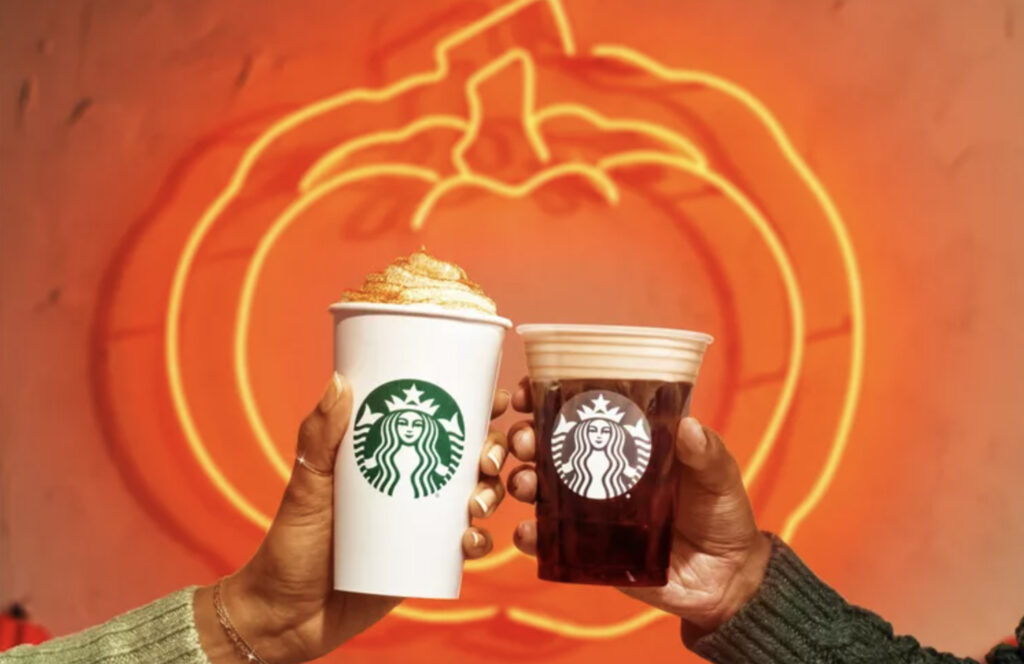
When Starbucks launches a new seasonal drink, like the Pumpkin Spice Latte, they aren’t just promoting a beverage; they’re promoting a feeling of comfort and familiarity associated with autumn.
This branding-led marketing approach results in about $100 million in revenue from the Pumpkin Spice Latte alone.
🌱 Marketing Brings Branding to Life
Consider Airbnb—a brand focused on inclusivity, belonging, and adventure. Their brand promise is “Belong Anywhere,” a message that invites travelers to experience local culture authentically.
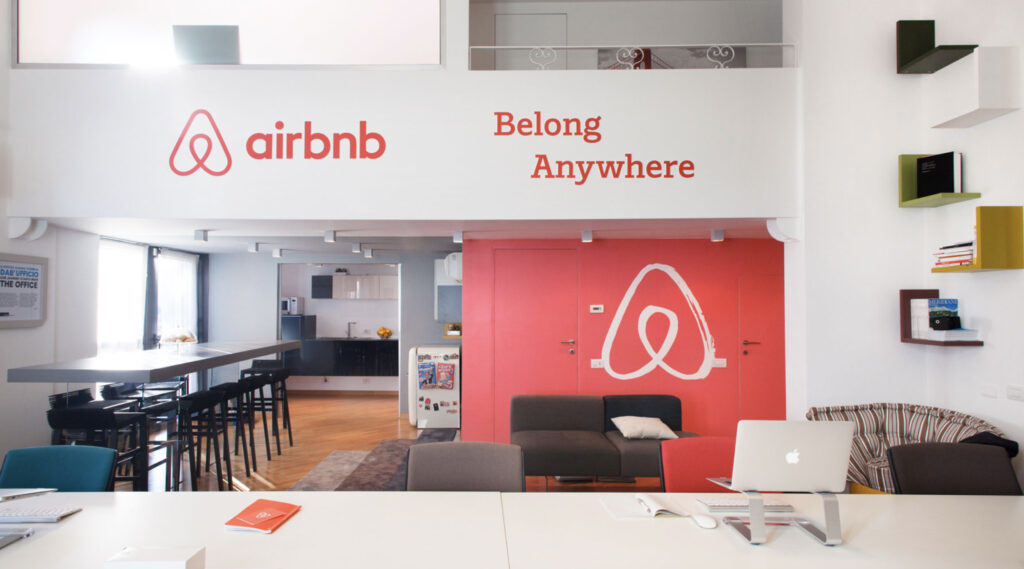
The AirBnb marketing campaigns, like “Live There” and “Made Possible by Hosts,” are extensions of this branding. Each campaign is crafted to reflect Airbnb’s commitment to local experiences, making their brand tangible and memorable.
This integration has been successful, with Airbnb achieving over 150 million users globally, driven by a brand-backed marketing strategy.
🧭 Branding Gives Marketing Direction
A strong brand gives marketing a clear focus. When you know who you are and what you stand for, marketing becomes a natural extension of that identity.
Branding informs everything from the tone of your copy to the look of your ads, helping marketing efforts stay aligned with your business’s core values.
When you have a brand strategy developed, every marketing decision that you make should align strategically.
Learn More: Brand Strategy Framework: A 5-Step Process to Help You Stand Out
🗺️ Marketing Puts Your Business On The Map
Without marketing, even the best brand is hard to find. Marketing puts your brand in front of the right people, making it accessible and relevant.
This is where the two really work together—branding establishes trust, while marketing brings that trust to new customers by showcasing what makes your business unique.
Advertising takes this even one step further by actively promoting your business in a way that prompts people to take action (such as buying something).
“Doing business without advertising is like winking at a girl in the dark—you know what you are doing, but nobody else does.” Steuart Henderson Britt
Why You Need Both Branding And Marketing
Businesses that succeed at both branding and marketing create an experience that resonates deeply with their audience.
Branding without marketing means you have an amazing product or service but never share it with anyone.
However:
Marketing without branding can create buzz but lacks the substance to turn that buzz into loyalty.

Let’s break down the branding vs. marketing chart shown above:
➡️ Long-term vs. Short-term
Branding is your long-term plan focusing on the development of a purpose and emotional impact in a strategic way. This long-term effort keeps your business memorable and relevant in the market to its core audience.
Marketing takes cues from that plan to help you execute short-term campaigns. These can center around driving awareness of your business, to promoting a specific offer. These short-term bursts of effort allow you to test the market, experiment, and gather data.
➡️ Purpose vs. Promotion
Branding is grounded in having a purpose behind doing business. It gives people a reason to believe in you across all touchpoints of the experience they have. Purpose also rallies employees around a business, supporting their efforts in a meaningful way.
Marketing amplifies that purpose in tangible ways through the activity of promotion, so that people feel inspired to buy from you over and over again. It showcases the Why behind a product or service, by communicating its impact.
➡️ Strategy-driven vs. Tactic-driven
Branding is strategic. It helps you define how your business stands out, connects, and inspires the right people to take action. Strategy it the plan that helps achieve the goal of building relationships needed for long-term loyalty.
Marketing is tactical. It aligns with the strategy and implements the right tactics to perform actions that need to be taken to achieve the goal.
➡️ Growth vs. Targeting
Branding is a way to organically grow an audience by crafting a positive perception for them. It is a broad effort to attract potential customers.
Marketing reaches a targeted audience – a group of people who are focused on through demographics, interests, and tailored messaging specific to converting them.
➡️ Builds Recognition vs. Generates Leads
Branding results in building recognition for your business – a know, like, and trust factor. This awareness becomes a familiarity that primes people to react favorably to targeted marketing efforts.
Marketing activities are made to generate leads by capturing people in a way that converts them into paying customers.
When branding and marketing services work in harmony, the result is a business, organization or cause that’s memorable, respected, and loved by its audience.
Conclusion
Branding vs. Marketing? They aren’t rivals. They’re a Dynamic Duo.
The reality is that branding and marketing make an awesome team, each bringing something unique to the table.
Branding is your core identity, the foundation that makes people trust and remember you (think of Apple, Coca-Cola, or Patagonia). It’s steady and long-lasting, like the North Star.
Marketing, on the other hand, is the energy—it’s adaptable, in-the-moment, and campaign-driven. It takes your brand identity and gets it out there, turning those values into action, like Coca-Cola’s “Share a Coke” or Patagonia’s push for sustainability.
In short –
Branding builds loyalty, and marketing drives engagement.
Together, they create a well-rounded experience that customers actually care about.
The key takeaway?
You don’t need branding or marketing; you need branding and marketing.
When you let branding set the tone and marketing make the connection, you don’t just capture attention—you build relationships that last.
Make your business a brilliant brand with a marketing strategy to amplify it at FreshSparks. Let’s chat.
THE ULTIMATE GUIDE TO BUILDING YOUR BRAND
Use our step-by-step branding process workbook with tips, templates, and guidance to help build a brand for your business! Define your target audience, research competitors, develop a voice…and more.

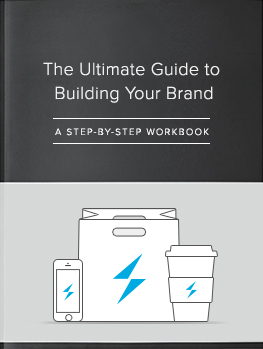
Leave a Reply